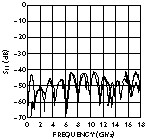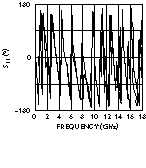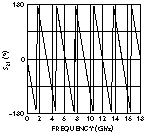THREE-SAMPLER NETWORK ANALYZER CALIBRATIONS
Calibration is the most important aspect of measurement with a network analyzer. The standard method for network analyzer calibration is short-open-load-through (SOLT) calibration.1 For calibration of four-sampler analyzers, the use of self-calibrating procedures is also possible in addition to the SOLT calibration. With self-calibration, fewer standards need to be measured during calibration, or a line is used instead of a matched load as a non-reflecting standard, which is particularly useful for calibrating analyzers with non-standard connectors. However, the use of self-calibrating procedures is restricted to four-sampler analyzers.2
Fig. 1 The signal flow graph for the standard 12-parameter error model with a device under test

This article describes some new calibration methods suitable for three-sampler analyzer calibration. They all provide some of the advantages of self-calibration methods over standard SOLT calibration, either by using fewer calibration standards, or by using a line instead of a matched load.
The standard error model for three-sampler analyzers is the 12-parameter error model, shown in Figure 1, while the standard error model for four-sampler analyzers is a cascade of two error boxes with a total of 7 independent parameters. Since it is not possible to represent a three-sampler analyzer as two cascaded error boxes, a 12-parameter error model must be determined by solving a system of nonlinear equations. The determination of the crosstalk errors EXF and EXR is trivial, thus only the determination of the remaining 10 parameters will be described.
TOSL CALIBRATION
The through-open-short-line (TOSL) calibration is a hybrid method, based on both the SOLT calibration and the through-reflect-line (TRL)3 self-calibration method. The supplied reference document provides only approximate solutions.4 An exact solution is given in this article. During calibration, the following need to be measured:
- Open circuit with reflection coefficient Γ0 (as with SOLT calibration) on both ports. The measurements are denoted M10 on port 1, and M2O on port 2, as shown in Figure 2 (Equations 1 and 2).
- A short circuit with reflection coefficient Γ8 (as with SOLT calibration) on both ports. The measurements are denoted M1S on port 1, and M2S on port 2 (Equations 3 and 4).
- Through connection (common to both SOLT and TRL calibration) of both ports and S-parameters S11T = S22T = 0 and S12T = S21T = 1. The raw measurements are denoted M11T , M12T M21T and M12T as shown in Figure 3 (Equations 5 to 8).
- Calibration line (as with TRL calibration) with propogation constant γ and length l, with the S-parameters S11L = S22L = 0 and S12L = S21L = e-γl . The raw measurements are denoted M11L , M12L M21L and M12L (Equations 9 to 12). Instead of the line, any matched reciprocal two-port element could be used. In such cases, the transmission parameterS21 would appear in the equations in place of the transmission coefficient e-γl of the line. If the parameters S11 and S22 are known, they can be incorporated into equations 9 to 12.
Fig. 2 Signal flow graph of the reflection standards' measurement on both ports of the analyzer; X is either K (known), R (reflect), O (open) or S (short).

Fig. 3 Signal flow graph of the two-port standard measurement; X is either T (through) or L (line).

The calibration measurements are described by 12 nonlinear scalar equations, which are derived directly from the signal flow graphs by applying the rules for solving flow graphs. Rearranged in a manner convenient for finding their solutions, they are:
|
|
ERF Γ0 + ESF Γ0 (M10 - EDF ) = M10 -EDF |
|
|
(1) |
|
|
ERR Γ0 + ESR Γ0 (M20 - EDR ) = M20 -EDR |
|
|
(2) |
|
|
ERF ΓS + ESF ΓS (M1S - EDF ) = M1S -EDF |
|
|
(3) |
|
|
ERR ΓS + ESR ΓS (M2S - EDR ) = M2S -EDR |
|
|
(4) |
|
|
EDF + ERF ELF = M11T + (EDF - M11T )ESF ELF |
|
|
(5) |
|
|
EDR + ERR ELR = M22T + (EDR - M22T )ESR ELR |
|
|
(6) |
|
|
ETF = M21T (l - ESF ELF ) |
|
|
(7) |
|
|
ETR = M12T (l - ESR ELR ) |
|
|
(8) |
|
|
EDF + ERF ELF e-2γl = M11L + (EDF - M11L )ESF ELF ELF e-γl |
|
|
(9) |
|
|
EDR + ERR ELR e-2γl = M22L + (EDR - M22L )ESR ELR ELF e-γl |
|
|
(10) |
|
|
ETF e-γl = M21L (I - ESF ELF e-2γl ) |
|
|
(11) |
|
|
ETR e-γl = M12L (I - ESR ELR e-2γl ) |
|
|
(12) |
Ten parameters of the model are determined from these equations, together with the transmission parameters of the calibration line. One of Equations 7, 8, 11 and 12 is redundant, since the line is a reciprocal element, but due to measurement errors it is beneficial to use all four of them. Similarly, in the TRL method, one of the measurements of the transmission parameters of the calibration line is also redundant, but is usually retained.
The system of Equations 1 to 12 can be solved by iteration. For a first approximation determination, the products ESF ELF and ESR ELR on the right side of Equations 5 to 12 are set to zero.
Each iteration consists of two steps. In the first step, the values of ETF and ETR are determined from Equations 7 and 8, eγl from Equations 11 and 12 and the two values averaged, EDF and the product ERF ELF from Equations 5 and 9, EDR and the product ERR ELR from Equations 6 and 10.
In the second step, the remaining four linear Equations 1 to 4 are solved for the unknowns ERF , ERR , ESF and ESR . Finally, parameter ELF is determined from the ERF ELF product, and parameter ELR from the ERR ELR product.
The estimated values of the parameters ESF , ELF , ESR and ELR from this iteration are then inserted into the right-hand side of Equations 5 to 12, and the whole iteration is repeated. The iteration procedure converges rapidly.
From Equations 5, 6, 9 and 10, it can be observed that e-2γl must not equal 1; in other words, the length of the calibration line with small losses must not be close to an integer multiple of the half-wavelength. This restriction also applies to TRL calibration, and is one of the weaknesses of this method. The possibility of using a matched attenuator instead of the calibration line is usually mentioned as a way to circumvent this limitation, since with attenuators, the transmission parameter is never equal to 1.
TKRL CALIBRATION
J.A. Jargon et al have proved5 that the following equation is valid for the three-sampler network analyzers:
|
|
ERF ERR = ETF ETR - ERF EDR • (ELF - ESR ) - ERR EDF (ELR - ESF ) - EDR EDF (ELF -ESR )(ELF - ESF ) |
|
|
(13) |
This relationship consequently means that three-sampler analyzers are completely determined by 11 independent parameters. Therefore, determination actually requires one measurement fewer than with the TOSL calibration previously described. For this reason, in the proposed through-known-reflect-line (TKRL) calibration, one of the reflection standards from TOSL calibration, now denoted as reflect, is not required to be known. Therefore, the following quantities must be measured in addition to through (Equations 5 to 8) and line (Equations 9 to 12):
· A standard with known reflection coefficient ΓK on both ports (usually open or short circuits). The measurements are denoted M1K on port 1, and M2K on port 2 (Equations 14 and 15).
· An auxiliary standard with (near) unknown reflection coefficient ΓR on both ports. Only the approximate phase of the reflection coefficient must be known for this standard, and the measurements are denoted M1R on port 1, and M2K on port 2 (Equations 16 to 17).
Fig. 4 The absolute value of S11 of the 10 cm MMC 2653 line using TOSL calibration.

The associated equations are
|
|
ERF ΓK + ESF ΓK (M1K - EDF ) = M1K - EDF |
|
|
(14) |
|
|
ERR ΓK + ESR ΓK (M2K - EDR ) = M2K - EDR |
|
|
(15) |
|
|
ERF ΓR + ESF ΓR (M1R - EDF ) = M1R - EDF |
|
|
(16) |
|
|
ERR ΓR + ESR ΓR (M2R - EDR ) = M2R - EDR |
|
|
(17) |
From Equations 5 to 17 (a total of 13, with one of them being redundant for the same reason that applies to TOSL calibration), 10 parameters of the model are determined, together with the reflection coefficient ΓR , and the transmission parameter of the calibration line.
The equations describing this calibration method are solved by using the same iterative procedure applied in the TKRL method. The first step of the iteration procedure is exactly the same. The second step is somewhat complicated, as the ΓR reflection coefficient is unknown.
Fig. 5 The absolute value of S11 of the 10 cm MMC 2653 line using TKRL calibration.

In the second step, the remaining five nonlinear Equations 13 to 17 are simultaneously solved for the five unknowns ERF , ERR , ESF , ESR and ΓR :

The right side of Equation 13 has been denoted as R13 . The sign in the expression for ΓR is determined from the approximate value of the phase of this reflection coefficient, which must be known in advance. The product ERF ELF determines parameter ELF , and the product EVR ELR determines parameter ELR . As in TOSL calibration, the length of the calibration line must not be close to an integer multiple of the half-wavelength.
TMKR CALIBRATION
The through-match-known-reflect (TMKR) method is based on through-match-reflect (TMR) calibration.6 It is very similar to the TKRL calibration previously described, the only difference being that a matched load, instead of the calibration line, is measured at both ports. Equations 11 and 12 are now identically zero and 9 and 10 are transformed into:
|
|
EDF = M11M |
|
|
(19) |
|
|
EDR = M22M |
|
|
(20) |
If the load is not ideally matched, and the reflection coefficient of the load on both ports is known, these values can be used in Equations 19 and 20. There are now 11 equations (Equations 5 to 8, Equations 13 to 17 and Equations 19 to 20) to be solved simultaneously to determine the 10 parameters of the error model and the reflection coefficient ΓR . The procedure is identical to the procedure for the TKRL method, where EDF and EDR are already determined by Equations 19 and 20 and ERF ELF and ERR ELR are determined from Equations 5 and 6.
VERIFICATION
The systems of nonlinear equations, which define all the proposed calibrations, are well conditioned for real analyzers. Thus, small errors in measurements lead to small errors in the determination of error model. Because absolute values of products ESF ELF and ESR ELR are small for real analyzers, the result of setting these products to zero in a first approximation is similar to ML and MT measured with error. The magnitude of these products for a model HP8720C analyzer is less than 0.03. For this reason, even the first approximation is very good and the iteration procedure converges rapidly. The procedure was also intensively tested by a computer simulation of a three-sampler network analyzer (with or without measuring errors) and the iteration procedure was successful, without exceptions, for all the proposed methods. The procedure was also tested on an HP8720C analyzer and was never at fault.
Verification measurements of the absolute value of S11 of a 10 cm Maury MMC2653 airline are shown in Figures 4 and 5. The measurements have been performed on a three-sampler HP8720C analyzer with APC7 connectors. A Maury model 2650F calibration kit and a 3 cm Maury MMC 2653 reference beadless air-line have been used for calibration. For reference, the same parameters also were measured by using standard SOLT calibration (dashed line).
Fig. 6 The absolute value of S21 of the 10 cm MMC 2653 line using TOSL calibration.

Fig. 7 The absolute value of S21 of the 10 cm MMC 2653 line using TKRL calibration.

Fig. 8 The phase of S11 of the 10 cm MMC 2653 line using TOSL calibration.

In the vicinity of 0, 5, 10 and 15 MHz (multiples of the half-wavelength of the calibration line), measurements cannot be performed by TOSL and TKRL calibrations, and therefore are missing. Figures 6 to 11 show S21 magnitude and S11 and S21 phase results.
CONCLUSION

Fig. 9 The phase of S11 of the 10 cm MMC 2653 line using TKRL calibration.

Fig. 10 The phase of S21 of the 10 cm MMC 2653 line using TOSL calibration.

Fig. 11 The phase of S21 of the 10 cm MMC 2653 line using TKRL calibration.
New calibration methods for three-sampler analyzers have been presented. The TOSL calibration method is useful as a direct substitute for the SOLT method for calibrating analyzers with nonstandard connectors, since it is much simpler to manufacture a precise line than a precise matched load.
Since the TKRL calibration is very similar to the TRL calibration, the accuracy of the TKRL calibration is close to TRL calibration, which is considered the most accurate calibration. However, one more reflection standard is required. For this reflection standard, a short circuit that is well defined and can be manufactured precisely for all connectors if not available commercially, is recommended. The same also applies for the proposed TMKR calibration compared with TMR calibration.
ACKNOWLEDGMENTS
The authors wish to thank Radko Osredkar and Matija Kostevc for assistance with the manuscript, and the Dielectric Laboratory of Jozef Stefan Institute, Ljubljana, for providing the measuring equipment.
References
1. J. Fitzpatrick, "Error Models for System Measurement," Microwave Journal, Vol. 21, No. 5, May 1978, pp. 63-66.
2. "New Network Analyzer Offers Choice of TRL Calibrations for Non Coaxial Measurement," HP 8510/8720 News, May 1996, Vol. 7, No. 1, pp. 1-3.
3. G.F. Engen and C.A. Hoer, "Thru-Reflect-Line: An Improved Technique for Calibration the Dual Six-port Automatic Network Analyzer," IEEE Transactions on Microwave Theory and Techniques, Vol. MTT-27, No. 12, December 1979, pp. 987-993.
4. M. Kostevc, J. Mlakar and L. Trontelj, "Calibration TRL for Automatic Network Analyzer with 12 Parameters Error Model," Melecon 85, Madrid 1985, Vol. III, pp. 23-26.
5. J.A. Jargon, R.B. Marks and D.K. Rytting, "Robust SOLT and Alternative Calibrations For Four-sampler Vector Network Analyzers," IEEE Transactions on Microwave Theory and Techniques," Vol. MTT-47, No. 10, October 1999, pp. 2008-2013.
6. H.J. Eul and B. Schiek, "Thru-Match-Reflect: One Result of a Rigorous Theory for De-embedding and Network Analyzer Calibration," 18th European Microwave Conference Proceedings, September 1988, pp. 909-914.
